The media and news industry, after 10 years of disruption and economic torture, finally thought that it had gotten a step ahead. Publishers were in on the ground floor when the tablet revolution started with products ready to go even before Steve Jobs introduced us to the original iPad. The marriage of tablets to publishing would be a boon for everybody.

The honeymoon has not been sweet.
Publishers did not have the tools to create fully functional magazines from the very start. Sure, they were nice looking, but that was about it. Over the last two years, though, publishers and developers have created dynamic tools that allow the news media to create apps that do not just meet user expectations, but go beyond them.
The growth of the toolset for publishers directly coincides with the rise of the startup community that has emerged to add new functionality to major mobile operating systems. For instance, Urban Airship, a cloud services provider for mobile, was probably not ready to fully unleash its suite for publishers when the iPad was first announced. Localytics, a mobile analytics company out of DogPatch labs in Boston, was just starting. Other cloud services like Kinvey, StackMob and Parse were nothing more than ideas.
What can these services offer now that was more difficult to do when publishers initially came around to the idea of tablet magazines and newspapers? Quite a bit, actually. Let’s look at what Urban Airship can do for publishers looking to put magazine apps in Apple’s iOS Newsstand.
- Newsstand library support: configures newsstand apps for auto-renewable subscriptions and single issue purchases through Apple’s in-app purchasing toolset.
- Content delivery: Hosts and delivers content available to users on any iOS device.
- Push notifications: This is a big one and perhaps one of the main items missing from original tablet apps. The ability to create easy push notifications enables publishers to put news right under the noses of users, increasing engagement and page views and alerting readers of new issues. The evolution of push notifications for mobile and tablet apps will be a critical piece in how publishers utilize the devices.
- Audience segmentation: Who is reading what? Where do you want to send certain readers? Urban Airship has “tags and aliases” features to associate mobile users with publishers CRM and personalize the experience.
- Free seed content: Users hate to download a news app and then automatically be forced to subscribe before getting content. Publishers need to sweeten the deal a little bit and give users free content, such as back issues, listed next to subscription services.
- Reports: How are users interacting with the news app? Analytics is the heart of understanding mobile users and there are a variety of companies out there, from Urban Airship, Localytics, Flurry, Apsalar and others that can help administrators reach the core goals of engagement and behavioral analysis.

What it comes down to is that publishers need to start looking at tablet apps like a developer would look at any other app, like a game or a utility. The goal is to gain reach, engage users, analyze behavior and monetize it. The Guardian and Future Publishing use Urban Airship and large publishers employ Flurry, Apsalar and Localytics for engagement and advertising insights.
There are also design tools that publishers can turn to for creating news apps that have evolved in the last year or so. Mag+ recently announced a new suite of publishing tools and pricing tiers for the smallest publisher to the largest magazine. Designed by editors and designers for editors and designers, it provides three tiers of publishing tools. There are also solutions from companies like Daylife, which launched real-time media management in June.
Apps are a data driven ecosystem, tied to the cloud, in the pockets of users on the go. News publishers need to understand the tools that can help them make the jump for the decaying old media standard to flexible and responsive new media technology companies.









